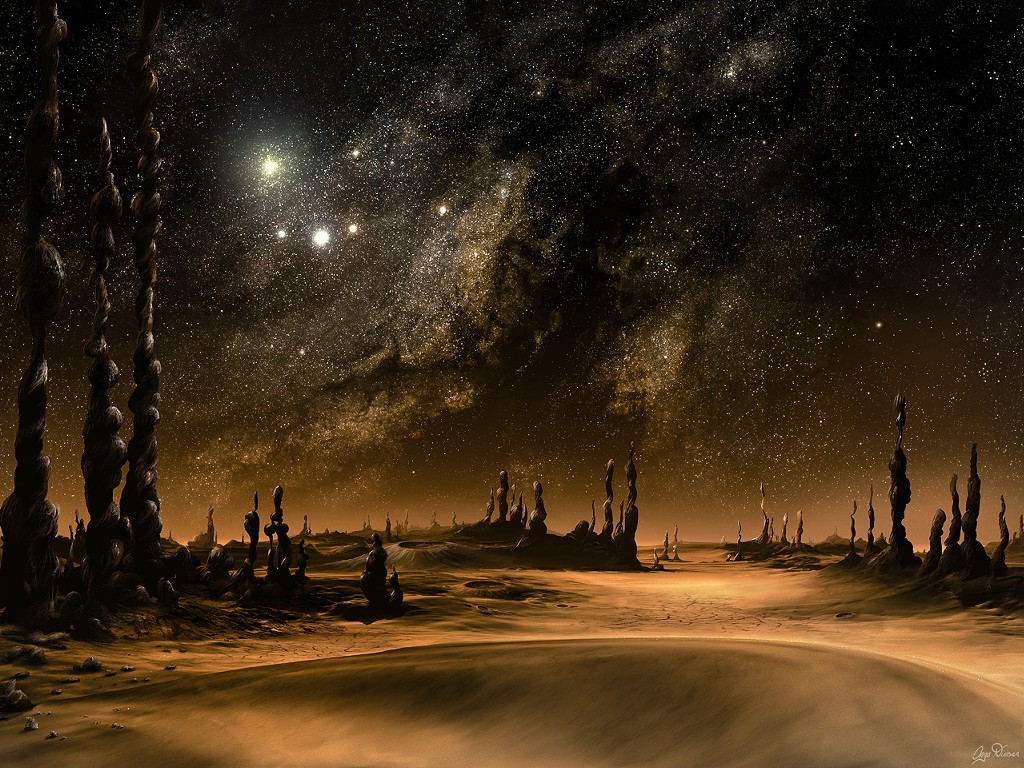
| Main | Neocene |

All pictures are taken from open sources and belong to their authors
The importance of the planet’s rotation speed for life on it
is rarely thought about. Unless, if you want to explain the gigantism of dinosaurs
with such a rapid, supposedly, rotation of the Earth 70 million years ago that
the centrifugal force “ate away” more than half of gravity… I’ll tell you right
now that it is a bad method. It doesn’t work. However, the world, indeed, can
live on the astronomical clock – other than modern terrestrial one.
The speed of rotation of the planet can vary widely. For example, the Venusian
day is 116.8 times longer than the Earth’s one, and the Mercurian day is 58.7
times longer. The Earth itself made one revolution in just eight hours four
billion years ago, and if it wasn’t for the Moon, the day would still be three
times shorter.
However, the maximum speed of rotation of the planet is limited. By itself,
the rotation around the axis perpendicular to the ecliptic plane occurs naturally
even at the stage of formation, when the nascent planet absorbs planetesimals
moving in close orbits. Obviously, small bodies of the protoplanetary ring can
move either in orbits slightly lower or slightly higher. And their angular velocity
will be higher in the first case and lower in the second. The blows spin the
growing planet in a quite predictable direction and up to a calculable speed.
Initially, the planets in the system rotate the faster the closer they are to
the star, since the absolute and relative velocities of small bodies are higher
in the near rings. And if in the case of the Earth the primary day was 8 hours,
then Mercury made a revolution around its axis in just 5-6 hours.
However, now the record holder of the Solar System in terms of rotation speed
is Jupiter, making one revolution in 9.5 hours. Only fragments formed as a result
of impacts rotate faster than it. There are no restrictions on the rotation
speed for small, secondary bodies – unless they may be torn apart by centrifugal
force.
How did it happen that Jupiter, which is quite far from the Sun, rotates the
fastest? It just turned out so. Over time, the rotation of the planets slows
down, insofar as due to tidal interactions with the moons, the Sun and other
planets, kinetic energy turns into thermal energy. For Mercury, which is light
and close to the Sun, this factor played a huge role. Just a few hundred million
years later, it entered a gravitational “half-lock”. Jupiter, huge and distant,
thumbed its nose at tidal effects. On the contrary, it only accelerated rotation
due to contraction. The other planets contract as they cool down, but only the
gas giants do it to a noticeable extent.

Small animals guided not by sight, but by sense
of smell, may have “biological full days”
(sleep-wake cycle) equal to 3-4 hours and not even multiple the solar day.
As a result, the upper layers of Jupiter’s atmosphere are now
flying at a speed of 12.6 km/s. This is more than the second cosmic velocity
for Earth and about 30% of the first cosmic velocity for Jupiter itself. At
its equator, the centrifugal force “eats away” almost a third of the weight.
For such an effect, our planet would have to make a revolution in about two
hours. Technically, it is not realistic to spin the Earth to such a speed with
a tangent blow, even if you use a projectile the size of Mars. The impact will
simply demolish the crust... which will carry the momentum into outer space.
The rotation will only slow down as a result… But it’s not the point. For the
practical consequence of rapid rotation on a “wet” planet will be flooding of
the equatorial region. Since, according to the law of communicating vessels,
three kilometers of a water column will be needed there to balance two kilometers
at the poles.
...However, what if? What if the day lasts 6 or 8 hours only? This day regimen
will favorably affect the climate, reducing the difference between daytime and
nighttime temperatures. Plants, small and sedentary animals will not be inconvenienced
by the short duration of the day (or night, if they are active in the dark).
But the big ones will simply not have time to find prey, kill it, eat it and
return to the lair so quickly. Predators will have to learn how to act in any
light, which may imply the presence of two sets of visual organs.
On the other hand, there is no upper limit on the duration of the day. If the
planet will be tidally locked, the day in one hemisphere and the night in the
other will become endless. And even if the duration of the day turns out to
be several times longer than on the Earth, the hot deserts will be heated by
the evening so that their inhabitants will have to hide in underground shelters.
By morning, the dunes will be covered with the hoarfrost… Nevertheless, for
a planet located far from the sun, too long a day can suddenly turn out to be
an advantage: where eternal winter should reign, spring will come by noon, and
hot summer by evening. Local residents will have to adapt to the stressful regime;
wake up when the world thaws under the rays of a dim but stubborn sun, and go
into hibernation shortly after sunset.
….At last, if there is more than one star in the system (in the Galaxy it is
the rule, not the exception), then... the influence of this factor will be insignificant.
The orbits of planets can maintain stability in multiple star systems for a
long time only if the stars are far from each other. “Far away” is farther than
50 astronomical units. A second sun at this distance would provide the Earth
with a bonus of +0.04% illumination. That is, the second component of the system
would not warm at all, but at night it would still give 100 times more light
than the full Moon. Such illumination is insufficient for photosynthesis, but
it is enough for creatures with daytime-adapted vision to act confidently during
the “midnight sun” nights. That is, a world with two luminaries, most likely,
will not give rise to owls and other animals adapted to the dark. The advantage
of night vision will affect only a quarter of the time, which will put them
at a disadvantage.
Translated by Pavel Volkov, 2021
The original Russian article is here
| Main | Neocene |